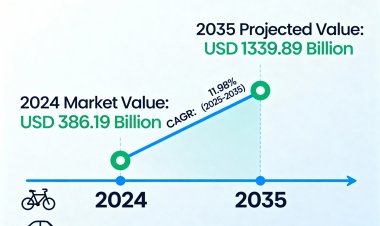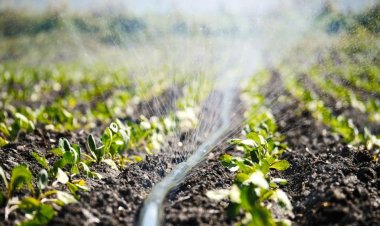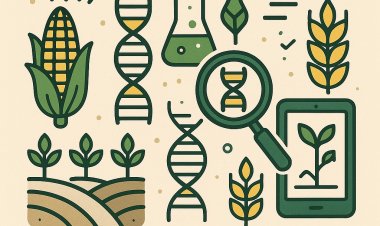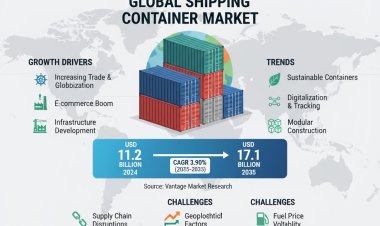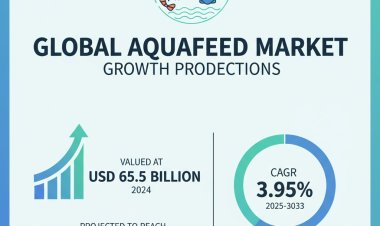Precision Farming Market Analysis 2022-2030: Growth, Innovations, and Future Trends
Explore the global precision farming market, including growth forecasts, technological innovations, key players, regional trends, challenges, and future outlook through 2030.

Precision Farming: Revolutionizing Agriculture for a Sustainable Future
Key Takeaways
- The global precision farming market is projected to grow from USD 8.7 billion in 2022 to over USD 21.4 billion by 2030, at a CAGR of 11.9%.
- Key drivers include rising food demand, technological advancements, and the need for sustainable agriculture.
- IoT, GPS, remote sensing, and autonomous machinery are transforming farm management.
- Hardware dominates the market, but services and software are rapidly gaining ground.
- North America leads the market, with Asia-Pacific and Europe showing significant growth potential.
- High costs, technological barriers, and regulatory challenges hinder widespread adoption.
- The future outlook is optimistic, with increasing investment and innovation expected to drive market expansion.
Market Overview and Growth Trajectory
The Global Precision Farming Market is experiencing a period of robust growth, driven by the convergence of technology and agriculture. According to analysts at Vantage Market Research, the market was valued at USD 8,709.18 million in 2022 and is projected to reach USD 21,410.06 million by 2030, reflecting a compound annual growth rate (CAGR) of 11.9% over the forecast period. This impressive trajectory underscores the increasing recognition of precision farming as a critical solution to the challenges facing modern agriculture, including food security, resource scarcity, and environmental sustainability.
Several key drivers are fueling this market expansion. First and foremost is the rising global population, which is expected to reach nearly 10 billion by 2050. This surge in population is intensifying the demand for food, putting pressure on farmers to increase yields while minimizing resource use and environmental impact. Precision farming offers a pathway to achieve these goals by enabling data-driven decision-making, optimizing input usage, and reducing waste.
Technological advancements are another major catalyst. The integration of digital technologies such as the Internet of Things (IoT), artificial intelligence (AI), and big data analytics has revolutionized farm management. These tools allow farmers to monitor crop health, soil conditions, and weather patterns in real time, leading to more informed and timely interventions.
Geographically, North America currently dominates the precision farming market, thanks to its advanced agricultural infrastructure, high adoption rates of new technologies, and supportive government policies. However, Asia-Pacific is emerging as a significant growth region, driven by increasing investments in agricultural modernization, rising awareness among farmers, and government initiatives to promote smart farming practices. Europe also presents substantial opportunities, particularly in countries like Germany, France, and the Netherlands, where sustainable agriculture is a top priority.
In summary, the precision farming market is on a strong upward trajectory, propelled by demographic trends, technological innovation, and the urgent need for sustainable agricultural practices. As the market continues to evolve, stakeholders across the value chain—from technology providers to farmers—stand to benefit from the transformative potential of precision agriculture.
Technological Innovations Driving Precision Farming
The rapid evolution of technology is at the heart of the precision farming revolution. Innovations in IoT, advanced analytics, GPS, remote sensing, and autonomous machinery are fundamentally changing how farmers manage their operations, leading to increased efficiency, productivity, and sustainability.
The Internet of Things (IoT) plays a pivotal role in precision farming by enabling the seamless collection and transmission of data from various sensors deployed across the farm. These sensors monitor a wide range of parameters, including soil moisture, temperature, humidity, and nutrient levels. By aggregating and analyzing this data, farmers can make precise decisions about irrigation, fertilization, and pest control, thereby optimizing resource use and minimizing environmental impact.
Advanced analytics and artificial intelligence further enhance the value of IoT-generated data. Machine learning algorithms can identify patterns and predict outcomes, such as disease outbreaks or yield estimates, allowing for proactive management. For example, predictive analytics can help farmers anticipate weather-related risks and adjust their planting schedules accordingly.
GPS and remote sensing technologies are also integral to precision farming. GPS-guided tractors and machinery enable precise planting, fertilization, and harvesting, reducing overlap and ensuring uniform application of inputs. Remote sensing, often facilitated by drones or satellites, provides high-resolution imagery of fields, allowing farmers to detect crop stress, nutrient deficiencies, and pest infestations early. This timely information supports targeted interventions, reducing the need for blanket applications of chemicals and promoting sustainable practices.
Emerging technologies such as autonomous tractors and robotic harvesters are poised to take precision farming to the next level. These machines can operate around the clock, performing tasks with unparalleled accuracy and efficiency. Autonomous equipment not only addresses labor shortages but also reduces operational costs and enhances safety.
In conclusion, technological innovation is the driving force behind the growth of precision farming. The integration of IoT, advanced analytics, GPS, remote sensing, and autonomous machinery is enabling a new era of data-driven agriculture, where every decision is informed by real-time insights and every resource is used optimally.
Key Market Segments and Applications
The precision farming market is characterized by a diverse array of offerings, applications, and end-users. Understanding the key market segments and their respective applications is essential for stakeholders seeking to capitalize on the opportunities in this dynamic industry.
The market can be broadly segmented into hardware, software, and services. Hardware currently accounts for the largest share, encompassing devices such as sensors, GPS receivers, drones, and automated machinery. These tools form the backbone of precision farming, enabling the collection and execution of data-driven insights. However, the software segment is rapidly gaining traction, driven by the increasing adoption of farm management platforms, data analytics tools, and mobile applications. These solutions help farmers interpret data, plan operations, and monitor progress in real time. Services, including consulting, training, and support, are also becoming increasingly important as farmers seek to maximize the value of their technology investments.
In terms of applications, precision farming is used across a wide range of agricultural activities. The most prominent applications include yield monitoring, soil monitoring, variable rate application, irrigation management, and crop scouting. Yield monitoring, which involves the use of sensors and GPS to track crop yields in real time, is one of the most widely adopted applications. This information helps farmers identify high- and low-performing areas of their fields, enabling targeted interventions to improve productivity.
Soil monitoring is another critical application, as it provides insights into soil health, nutrient levels, and moisture content. By understanding the specific needs of different areas within a field, farmers can apply fertilizers and water more efficiently, reducing costs and environmental impact. Variable rate technology (VRT) allows for the precise application of inputs based on real-time data, further enhancing efficiency and sustainability.
Other notable applications include pest and disease management, where remote sensing and AI-powered analytics help detect early signs of infestation or infection, enabling timely and targeted treatments. Irrigation management systems use soil moisture sensors and weather data to optimize watering schedules, conserving water and improving crop health.
In summary, the precision farming market is composed of a diverse range of hardware, software, and services, each playing a vital role in enabling data-driven agriculture. The main applications—yield monitoring, soil monitoring, variable rate application, and irrigation management—are transforming how farmers manage their operations, leading to higher productivity, lower costs, and more sustainable practices.
Competitive Landscape and Major Players
The precision farming market is highly competitive, with a mix of established agricultural giants, technology innovators, and emerging startups vying for market share. The competitive landscape is characterized by rapid innovation, strategic partnerships, and a focus on delivering integrated solutions that address the evolving needs of modern farmers.
Leading companies in the precision farming space include John Deere, Trimble Inc., AGCO Corporation, Raven Industries, and CNH Industrial. These firms have established themselves as industry leaders through a combination of technological innovation, extensive product portfolios, and global reach. John Deere, for example, has invested heavily in developing advanced machinery equipped with GPS, IoT, and AI capabilities, enabling farmers to automate and optimize a wide range of tasks.
Trimble Inc. is another key player, known for its expertise in GPS and positioning technologies. The company offers a suite of precision agriculture solutions, including guidance systems, field mapping, and data analytics platforms. AGCO Corporation and CNH Industrial have also made significant strides in integrating digital technologies into their equipment, offering farmers comprehensive solutions for planting, fertilizing, and harvesting.
The competitive landscape is further shaped by mergers, acquisitions, and collaborations. In recent years, there has been a wave of consolidation as companies seek to expand their capabilities and market reach. For example, John Deere’s acquisition of Blue River Technology, a leader in machine learning and robotics for agriculture, has strengthened its position in the precision farming market. Similarly, AGCO’s acquisition of Precision Planting has enhanced its offerings in planting technology.
Startups and technology firms are also making their mark, particularly in areas such as data analytics, remote sensing, and farm management software. Companies like Climate Corporation (a subsidiary of Bayer), Farmers Edge, and Granular are leveraging big data and AI to provide farmers with actionable insights and decision support tools.
To capture market share, leading players are focusing on innovation, customer-centric solutions, and strategic partnerships. Many are investing in research and development to stay ahead of technological trends, while others are forming alliances with software providers, agronomists, and research institutions to deliver integrated solutions.
In conclusion, the precision farming market is characterized by intense competition, rapid innovation, and a focus on delivering value to farmers. The leading companies are leveraging technology, strategic partnerships, and acquisitions to strengthen their market positions and drive the adoption of precision agriculture worldwide.
Regional Analysis: Spotlight on Key Markets
The adoption and growth of precision farming vary significantly across regions, influenced by factors such as technological infrastructure, government policies, and agricultural practices. A closer look at key markets reveals distinct trends and opportunities.
North America remains the dominant force in the global precision farming market. The region’s leadership is attributed to its advanced agricultural sector, high level of mechanization, and widespread adoption of digital technologies. The United States, in particular, has been at the forefront of precision agriculture, with large-scale farms investing in GPS-guided equipment, IoT sensors, and data analytics platforms. Government support, in the form of subsidies and research funding, has further accelerated adoption. Canada is also making significant strides, particularly in the Prairie provinces, where precision farming is helping to optimize wheat and canola production.
Europe is another key market, with countries like Germany, France, and the Netherlands leading the way. The European Union’s focus on sustainable agriculture and environmental protection has driven the adoption of precision farming practices. Initiatives such as the Common Agricultural Policy (CAP) and the European Green Deal are encouraging farmers to embrace technologies that reduce input use and minimize environmental impact. Precision farming is particularly prevalent in high-value crops such as fruits, vegetables, and vineyards, where quality and sustainability are paramount.
Asia-Pacific is emerging as a high-growth region, driven by the need to increase food production and improve resource efficiency. Countries like China, India, and Australia are investing in agricultural modernization, with governments launching initiatives to promote smart farming. In India, for example, the government’s Digital Agriculture Mission aims to leverage technology to enhance productivity and sustainability. However, adoption rates vary widely across the region, with smallholder farmers facing challenges related to cost, awareness, and access to technology.
Other regions, such as Latin America and the Middle East & Africa, are also beginning to explore the benefits of precision farming. In Brazil and Argentina, large-scale soybean and corn producers are adopting precision technologies to improve yields and reduce costs. In Africa, pilot projects and partnerships with international organizations are helping to introduce precision farming to smallholder farmers, with a focus on improving food security and resilience to climate change.
In summary, regional trends in precision farming are shaped by a combination of technological readiness, policy support, and agricultural practices. While North America and Europe lead in adoption, Asia-Pacific and other regions offer significant growth potential as awareness and investment in smart agriculture continue to rise.
Challenges and Barriers to Adoption
Despite its many benefits, the widespread adoption of precision farming faces several challenges and barriers. Understanding these obstacles is crucial for stakeholders seeking to accelerate the transition to data-driven agriculture.
One of the most significant barriers is the high cost of implementation. Precision farming technologies, such as GPS-guided equipment, IoT sensors, and advanced analytics platforms, require substantial upfront investment. For small and medium-sized farms, these costs can be prohibitive, limiting adoption to larger, well-capitalized operations. While prices are gradually decreasing as technology matures, affordability remains a key concern, particularly in developing regions.
Market awareness and education are also critical challenges. Many farmers, especially in emerging markets, are not fully aware of the benefits of precision farming or lack the technical knowledge to implement and maintain these systems. Bridging this knowledge gap requires targeted outreach, training programs, and demonstration projects to showcase the value of precision agriculture.
Technological barriers are particularly pronounced in developing nations, where access to reliable internet connectivity, electricity, and technical support may be limited. The lack of infrastructure can hinder the deployment and effective use of precision farming tools, especially in remote or underserved areas.
Data privacy and security concerns are also emerging as more farm data is collected, stored, and analyzed. Farmers may be hesitant to share sensitive information with technology providers, fearing misuse or unauthorized access. Establishing clear data governance frameworks and ensuring transparency are essential to building trust and encouraging adoption.
Climate change and environmental regulations present both challenges and opportunities. On one hand, precision farming can help farmers adapt to changing weather patterns and comply with environmental standards by optimizing input use and reducing emissions. On the other hand, increasingly stringent regulations may require additional investments in technology and compliance, adding to the cost burden.
In conclusion, while precision farming holds immense promise, overcoming barriers related to cost, awareness, infrastructure, and regulation is essential to unlocking its full potential. Collaborative efforts among governments, industry, and research institutions are needed to address these challenges and ensure that the benefits of precision agriculture are accessible to all.
Future Outlook: Market Forecasts and Trends
The future of precision farming is bright, with strong growth prospects and ongoing innovation set to reshape the agricultural landscape. According to market forecasts, the global precision farming market is expected to reach USD 21,410.06 million by 2030, growing at a CAGR of 11.9% from 2022 to 2030. This growth will be driven by a combination of technological advancements, increasing investment, and the urgent need for sustainable food production.
Several trends are expected to shape the evolution of the market over the coming years. The integration of artificial intelligence and machine learning will enable even more sophisticated data analysis, supporting predictive and prescriptive decision-making. Autonomous machinery will become increasingly common, reducing labor requirements and improving operational efficiency. The use of blockchain technology for supply chain transparency and traceability is also gaining traction, particularly in high-value crops and organic produce.
Consumer behavior is evolving, with growing demand for sustainably produced food and greater transparency in the supply chain. Precision farming enables farmers to meet these expectations by optimizing resource use, reducing environmental impact, and providing detailed information about production practices.
For stakeholders and investors, the precision farming market offers significant opportunities. Technology providers can capitalize on the growing demand for integrated solutions, while investors can benefit from the sector’s strong growth prospects. Governments and policymakers have a critical role to play in supporting adoption through incentives, research funding, and infrastructure development.
In summary, the outlook for precision farming is highly positive, with continued innovation and investment expected to drive market expansion. By embracing new technologies and collaborative approaches, the agriculture industry can achieve higher productivity, sustainability, and resilience in the face of global challenges.
☎ Contact Us:
224 W 35th St Ste 500 New York,
USA/Canada Toll Free +1(877) 462-2282
+1(212) 951-1369
✉ Email: [email protected]
???? Website: https://www.vantagemarketresearch.com
FAQs
- What is the current market size of the Global Precision Farming market?
- What factors are contributing to the growth of the Precision Farming market?
- What is the projected market value of the Global Precision Farming market by 2030?
- What is the expected compound annual growth rate (CAGR) for the Precision Farming market during the forecast period?









